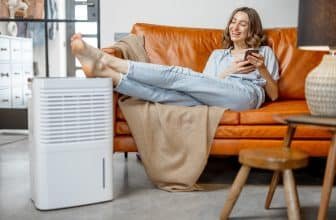Ultraviolet (UV) Air Purifiers: How They Work and Their Benefits
Ultraviolet (UV) air purifiers are a type of air purification system that uses ultraviolet light to remove airborne contaminants and improve indoor air quality. These purifiers are becoming increasingly popular due to their ability to kill germs, viruses, and bacteria in the air. They are especially useful in hospitals, schools, and other public places where people are more susceptible to airborne illnesses.

UV air purifiers work by using ultraviolet light to kill microorganisms in the air. The light damages the DNA of these organisms, rendering them harmless. This type of air purifier is particularly effective against viruses and bacteria that can cause illnesses such as the flu, colds, and other respiratory infections. However, it is important to note that UV air purifiers are not effective against allergens such as dust, pollen, and pet dander.
UV Air Purifiers: Illuminating the Technology and Health Benefits
- UV air purifiers use ultraviolet light to kill germs, viruses, and bacteria in the air.
- They are particularly effective in public places where people are more susceptible to airborne illnesses.
- UV air purifiers are not effective against allergens such as dust, pollen, and pet dander.
Understanding UV Air Purifiers
UV air purifiers are devices that use ultraviolet (UV) light technology to capture air and pass it through a filter. The air then goes through a small internal chamber where it becomes exposed to UV light, which has the ability to sanitize the air by neutralizing airborne contaminants. This section will explore how UV air purifiers work, the types of UV light used in purifiers, and the role of UV-C in air sanitization.
How UV Air Purifiers Work
UV air purifiers work by using UV light to inactivate airborne pathogens and microorganisms like mold, bacteria, and viruses. The UV light used in these purifiers is typically in the germicidal range, which means it has the ability to kill or deactivate microorganisms. When air is passed through the purifier, the UV light shines on the microorganisms, damaging their DNA and rendering them unable to reproduce.
Types of UV Light Used in Purifiers
There are three types of UV light: UV-A, UV-B, and UV-C. UV-A and UV-B are not used in air purifiers because they do not have the ability to kill microorganisms. UV-C, on the other hand, is used in air purifiers because it has the ability to inactivate microorganisms. Germicidal UV-C light has a wavelength of 254 nanometers, which is the most effective wavelength for killing microorganisms.
The Role of UV-C in Air Sanitization
UV-C has the ability to sanitize the air by killing or deactivating microorganisms. When air is passed through a UV air purifier, the UV-C light shines on the microorganisms, damaging their DNA and rendering them unable to reproduce. This process is known as air sanitization. UV air purifiers are effective at removing a variety of microorganisms from the air, including bacteria, viruses, and mold.
In conclusion, UV air purifiers are effective at sanitizing the air by using UV-C light to kill or deactivate microorganisms. The germicidal UV-C light has a wavelength of 254 nanometers, which is the most effective wavelength for killing microorganisms. When air is passed through a UV air purifier, the UV-C light shines on the microorganisms, damaging their DNA and rendering them unable to reproduce. UV air purifiers are effective at removing a variety of microorganisms from the air, including bacteria, viruses, and mold.
Benefits of UV Air Purifiers
UV air purifiers have become increasingly popular in recent years due to their ability to eliminate airborne pathogens and reduce allergens and irritants. These purifiers use ultraviolet light to kill bacteria, viruses, and mold that can cause sickness and allergies. Here are some of the benefits of UV air purifiers:
Elimination of Airborne Pathogens
UV air purifiers are effective in eliminating airborne pathogens such as bacteria and viruses. According to a Medical News Today article, UV light can destroy the DNA of these pathogens, rendering them harmless. This can be especially beneficial for people with weak immune systems or those who are prone to infections.
Reduction of Allergens and Irritants
UV air purifiers can also help reduce allergens and irritants in the air. They can neutralize pet dander, pollen, and other airborne allergens that can cause allergies and asthma. By reducing these allergens, people with allergies and respiratory problems can breathe easier and experience less discomfort.
Odor Neutralization
UV air purifiers can also neutralize unpleasant odors in the air. They can eliminate the smell of smoke, cooking odors, and other unpleasant smells that can linger in the home. This can be especially beneficial for people who have pets or live in areas with high levels of pollution.
In addition to these benefits, UV air purifiers are also easy to use and maintain. They do not require any filters to be replaced, which can save money in the long run. Overall, UV air purifiers can provide a range of benefits for people who want to breathe cleaner, healthier air.
Comparing UV Air Purifiers with Other Purifiers

When it comes to air purifiers, there are several types available in the market, each with its own set of features and functionalities. In this section, we will compare UV air purifiers with other popular types of air purifiers.
HEPA Filters vs. UV-C Technology
HEPA filters are one of the most common types of air filters used in air purifiers. They are highly effective in removing small particles such as dust, pollen, and pet dander from the air. However, HEPA filters are not effective in removing volatile organic compounds (VOCs) or other gases from the air.
On the other hand, UV-C technology used in air purifiers is effective in killing germs and bacteria present in the air. UV-C technology works by emitting ultraviolet radiation that destroys the DNA of these microorganisms, rendering them inactive and unable to reproduce. UV-C technology is also effective in removing odors from the air.
The Use of Ionizers in Air Purifiers
Ionizers are another type of air purifier that work by releasing negatively charged ions into the air. These ions attach themselves to positively charged particles such as dust and pollen, causing them to become heavy and fall to the ground. However, ionizers are not effective in removing gases and odors from the air.
UV air purifiers, on the other hand, use UV-C technology to kill germs and bacteria, as well as remove odors from the air. While ionizers can be effective in removing certain types of particles from the air, they are not as effective as UV air purifiers in removing harmful microorganisms.
Activated Carbon Filters and VOCs
Activated carbon filters are effective in removing VOCs and other gases from the air. These filters work by adsorbing these gases onto the surface of the filter material. However, activated carbon filters are not effective in removing particles such as dust and pollen from the air.
UV air purifiers are effective in removing germs and bacteria from the air, as well as removing odors. While they are not as effective as activated carbon filters in removing VOCs and other gases from the air, they do provide a good level of protection against harmful microorganisms.
In conclusion, each type of air purifier has its own set of features and functionalities. While HEPA filters are effective in removing small particles from the air, they are not effective in removing gases and odors. Ionizers are effective in removing certain types of particles from the air, but they are not as effective as UV air purifiers in removing harmful microorganisms. Activated carbon filters are effective in removing VOCs and other gases from the air, but they are not effective in removing particles such as dust and pollen. UV air purifiers are effective in removing germs and bacteria from the air, as well as removing odors, making them a good choice for those looking for a well-rounded air purifier.
Safety and Efficacy
Is UV-C Light Safe for Home Use?
UV-C light is generally safe for home use, but it can be harmful to humans and pets if not used properly. According to a source, UV-C light can cause skin and eye irritation, and prolonged exposure can lead to skin cancer. It is important to ensure that the UV-C light is properly shielded and that the air purifier has safety features to prevent exposure.
Effectiveness of UV Air Purifiers
UV air purifiers are effective at disinfecting the air and removing harmful bacteria and viruses. According to a source, UV air purifiers that use a HEPA filter can be effective at removing bacteria from the air. However, it’s important to note that UV air purifiers are not effective at removing allergens, dust, and other particulate matter from the air.
Potential Production of Ozone
UV air purifiers can potentially produce ozone gas, which can be harmful to humans and pets if inhaled in large quantities. According to a source, ozone gas can cause respiratory problems and aggravate existing respiratory conditions such as asthma. It’s important to ensure that the UV air purifier does not produce ozone gas and that it has been certified by a reputable organization such as the California Air Resources Board.
Maintenance and Care

UV air purifiers require some maintenance and care to ensure they function effectively and last a long time. Here are some important aspects of maintenance and care:
Cleaning and Replacing Filters
UV air purifiers usually come with a pre-filter that traps larger particles like dust and pet hair. This pre-filter needs to be cleaned or replaced periodically to ensure optimal performance. Some models have a filter replacement indicator that alerts the user when it’s time to replace the filter.
In addition to the pre-filter, UV air purifiers may also have a HEPA filter that captures smaller particles like pollen and smoke. The HEPA filter needs to be replaced less frequently than the pre-filter, but it’s still important to check it periodically and replace it when necessary.
Longevity of UV-C Bulbs
The UV-C bulb is the component of the UV air purifier that emits the ultraviolet light to kill microorganisms. These bulbs have a lifespan of around 9,000 hours, after which they need to be replaced. Some models have a bulb replacement indicator that alerts the user when it’s time to replace the bulb.
Overall Durability of UV Air Purifiers
UV air purifiers are generally durable and long-lasting, but they do require some care to ensure they last as long as possible. It’s important to follow the manufacturer’s instructions regarding maintenance and care, and to clean the unit periodically to remove any dust or debris that may accumulate.
In conclusion, with proper maintenance and care, UV air purifiers can provide effective air purification for many years. By cleaning and replacing filters, monitoring the longevity of UV-C bulbs, and taking care of the overall durability of the unit, users can ensure the optimal performance of their UV air purifiers.
Selecting the Right UV Air Purifier
When it comes to selecting the right UV air purifier, there are several factors to consider. With so many options available, it can be overwhelming to choose the best one for your needs. In this section, we will discuss the factors to consider when buying a UV air purifier, the top-ranked UV air purifier models, and how to read and understand reviews.
Factors to Consider When Buying
Before purchasing a UV air purifier, it is important to consider several factors. The following are some of the most important factors to keep in mind:
-
Room size: Choose a UV air purifier that is appropriate for the size of the room you want to use it in. A purifier that is too small for the room will not be effective, while a purifier that is too large will be a waste of money.
-
Filtration system: Look for a UV air purifier that has a high-quality filtration system. Some of the best air purifiers have a HEPA filter, which can remove up to 99.97% of particles that are 0.3 microns or larger.
-
Noise level: Consider the noise level of the air purifier. If you plan to use it in a bedroom or other quiet space, choose a purifier that operates quietly.
-
Energy efficiency: Look for a UV air purifier that is energy efficient to save on your electricity bill.
Top-Ranked UV Air Purifier Models
There are several top-ranked UV air purifier models on the market. The following are some of the best options:
-
GermGuardian AC4825: This air purifier is highly rated by customers and has a HEPA filter, UV-C light, and charcoal filter to remove odors.
-
Austin Air HealthMate: This air purifier is designed to remove a wide range of pollutants, including dust, pollen, and chemicals.
-
Winix 5500-2: This air purifier has a HEPA filter, carbon filter, and plasma wave technology to remove pollutants and allergens.
-
Coway Airmega 400: This air purifier has a dual filtration system, including a HEPA filter and activated carbon filter, and can clean the air in a room up to 1,560 square feet.
Reading and Understanding Reviews
When reading reviews of UV air purifiers, it is important to look for reviews from customers who have used the product for an extended period of time. Look for reviews that mention the effectiveness of the purifier in removing pollutants and allergens, as well as the noise level and ease of use. Be wary of reviews that seem overly positive or negative, as they may not be genuine.
Practical Applications and Settings
UV air purifiers are versatile devices that can be used in a wide variety of settings to improve indoor air quality. Here are some practical applications and settings where UV air purifiers can be used effectively.
Household Use and Placement
In households, UV air purifiers can be placed in various rooms to target specific indoor air pollutants. For example, they can be installed in kitchens to remove cooking odors and reduce the spread of bacteria and viruses. They can also be placed in living rooms, bedrooms, and other areas to eliminate pet dander, smoke, and other common allergens. It is recommended to place a UV air purifier in a central location to ensure maximum air circulation.
Commercial and Medical Facilities
UV air purifiers are commonly used in commercial and medical facilities to maintain clean and healthy environments. They are particularly useful in laboratories, hospitals, and other medical settings where the spread of bacteria and viruses can be a concern. In these settings, UV air purifiers are often used in conjunction with other air filtration systems to provide comprehensive air purification.
Special Considerations for Sensitive Environments
UV air purifiers can also be used in sensitive environments such as clean rooms and data centers where the presence of even small amounts of dust or debris can be detrimental. In these settings, UV air purifiers are often used in combination with HEPA filters to remove even the smallest particles from the air. It is important to note that UV air purifiers should not be used as the sole method of air filtration in these settings, and should be used in conjunction with other air purification methods.
Overall, UV air purifiers are a practical and effective way to improve indoor air quality in a variety of settings. They can help to remove common indoor air pollutants such as pet dander, smoke, and cooking odors, as well as reduce the spread of bacteria and viruses. Whether used in households, commercial facilities, or sensitive environments, UV air purifiers are a valuable tool for maintaining clean and healthy indoor air.
Frequently Asked Questions
What are the benefits of using an air purifier with UV light?
Air purifiers with UV light technology are designed to eliminate harmful particles and improve indoor air quality. They are effective in destroying bacteria, viruses, and other microorganisms that can cause illness. UV air purifiers can also help reduce odors and improve the overall freshness of indoor air.
How do UV air purifiers compare to HEPA filters in terms of effectiveness?
UV air purifiers and HEPA filters are both effective in improving indoor air quality, but they work in different ways. HEPA filters capture airborne particles, such as dust, pollen, and pet dander, while UV air purifiers use ultraviolet light to kill bacteria and viruses. Combining both technologies can provide optimal air purification.
Can UV air purifiers be safely used in residential settings without harmful side effects?
UV air purifiers are generally safe to use in residential settings when used according to manufacturer instructions. However, prolonged exposure to UV-C light can be harmful to humans and pets. It is important to choose a UV air purifier that has safety features, such as automatic shut-off when the device is opened or tilted.
Are there specific features to look for when choosing the best UV air purifier?
When choosing a UV air purifier, consider the size of the room, the type of filter used, and the additional features offered. Look for a device that has a high CADR (Clean Air Delivery Rate) and a filter that is easy to replace. Additional features, such as automatic shut-off and air quality sensors, can also be helpful.
How does UV technology in air purifiers contribute to indoor air quality?
UV technology in air purifiers contributes to indoor air quality by destroying bacteria, viruses, and other microorganisms that can cause illness. UV-C light disrupts the DNA of microorganisms, rendering them unable to reproduce or cause harm. This technology can also help reduce odors and improve the overall freshness of indoor air.
What should consumers know about the potential ozone emissions from UV air purifiers?
Some UV air purifiers can emit ozone, which can be harmful to humans and pets when inhaled in large quantities. It is important to choose a UV air purifier that is certified by reputable organizations, such as the California Air Resources Board, to ensure that it meets safety standards. Look for a device that emits low or no ozone to minimize potential risks.
best air purifiers
My name is Philipp Walz, editor at best-air-purifiers.com, and I’m truly passionate about creating healthier living spaces through smart, effective air purification. For me, air purifiers aren’t just appliances – they’re a quiet revolution in how we breathe, live, and feel at home. Clean air means better sleep, clearer thinking, and fewer allergies. It’s about giving our bodies what they need most: pure, fresh air. I’ve experienced firsthand how the right air purifier can transform a space and improve well-being – and I’m here to help others discover that difference. Because when you breathe better, you live better.






